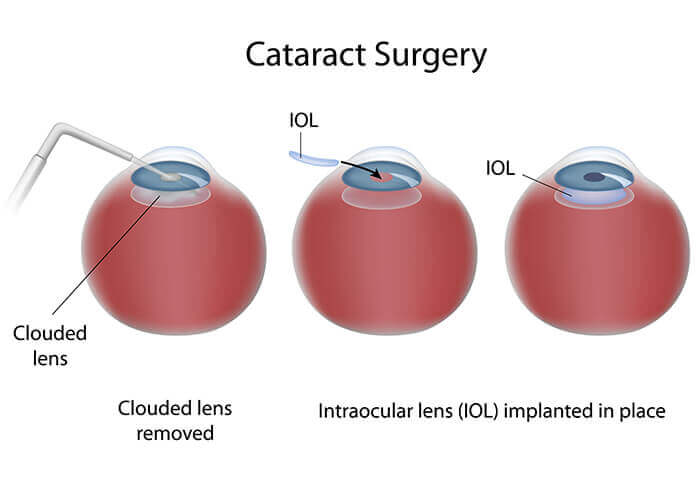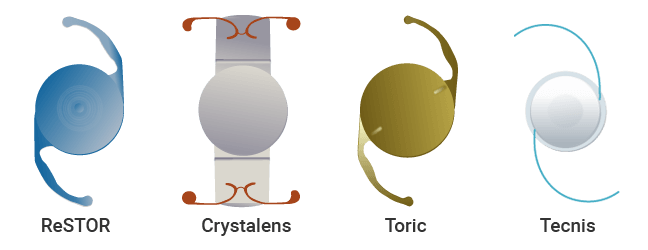Is your vision foggy or blurry? Do colors appear dull or not sharp? Do your eyes hurt when you go out in the sun? If you answered YES to these questions you may be experiencing cataracts.
What is a Cataract • How Does Surgery Work? • What do I Need to Know? • Dr. Salz’s Own Experience
1. What is a cataract?
A cataract is a clouding of the eye’s naturally clear lens. The lens typically becomes cloudy and has a bit of a yellowish hue to it. When the natural lens experiences this clouding effect, vision quality is diminished. Many people describe this sensation as looking through a foggy car window or a piece of wax paper. Cataracts can be burdensome especially to people who have had clear vision most of their life.
The lens in your eye is responsible for focusing light rays on the retina, which is the part of the eye that senses light and transmits these images to the brain. When the natural lens becomes cloudy light rays cannot possibly pass through. Vision becomes blurry at this point and as the cataract develops it becomes increasingly difficult to see. Developing cataracts is part of the normal aging process. It has been stated by many eye doctors that if you live long enough you will develop cataracts.
What causes a cataract?
Cataracts are caused mainly by age, trauma, heredity, and exposure to ultraviolet radiation. Cataracts can also occur as a result of eye disease, after the use of certain medications, or as a result of medical conditions such as diabetes.
- Getting Older – Age is a major cause of developing cataracts.
- Birth defect like abnormal conditions in the eyes of unborn babies
- Environmental factors such as disease, toxic chemicals, medications
- Accidents or Injuries
- Exposure to ultraviolet light
- Cigarette Smoking
2. Cataract Surgery
Cataract surgery is the only way to remove a cataract and restore clear vision. Our cataract surgery expert will recommend cataract surgery when the cataracts begin to limit your activities.
During cataract surgery, the natural lens of your eye is removed and replaced with a clear artificial lens called an intraocular lens implant. The surgical process involves a small incision phacoemulsification technique and why many eye doctors refer to this as micro-surgery. This means that the cataract surgery is accomplished using the smallest possible incision, and removal of the lens material is accomplished using an ultrasonic needle. Once the eye has been properly dilated, the eye is then prepared with a cleaning solution. Topical anesthetic is then administered to the surface of the eye. Next, under a microscope an incision of 3 millimeters in length is then created at the junction of the cornea (the clear structure on the front of the eye) and the sclera (the white part of the eye). Another dose of anesthetic is then administered inside the eye through this incision. The front part of the lens envelope, know as the lens capsule, is carefully opened so that the lens material can be removed. This is accomplished using a needle-like ultrasonic device, which pulverizes the hardened and yellowed lens proteins known as the cataract. The pulverized material is simultaneously vacuumed from the eye.

Once all of the cataract material has been removed a foldable intraocular lens is then inserted through the original incision and positioned into the lens capsule. The lens will remain inside your eye in this location without moving. Intraocular lenses cannot be felt or sensed in any way by the patient.
Cataract surgery is virtually painless and recovery is quick. Your eye may be patched when you leave the facility, but the patch will be removed the next day. You will notice improvement in your vision; however, you may still need glasses for some tasks.
3. What do I need to know about cataract surgery?
As previously mentioned you will have an intraocular lens implant placed inside your eye after the cataract is removed.

This is where you have a distinct opportunity to decide how well you will see after surgery. There are 3 main types of lens implants that will affect how you see after cataract surgery. If you select the premium lens option there is a possibility you can see without dependence on glasses at near, far and intermediate distances. We highly suggest consulting a premium cataract surgeon for advice pertaining to your specific visual condition.
- Monofocal IOL
A monofocal IOL is an intraocular lens with a fixed focus for one distance. - Multifocal IOL
Multifocal intraocular lenses allow you to see a range of distances. Instead of choosing just one distance, you can both read a book and see a sign on the road. - Toric Intraocular Lens (IOL)
This lens design provides quality distance vision and astigmatism correction. - Trifocal IOL
Trifocal IOL is a type of multifocal IOL used to focus images clearly. - Accommodating IOL
Accommodating IOLs correct your nearsightedness, farsightedness or cataracts while also treating presbyopia to reduce your dependence on reading glasses.
Dr. Salz’s own experience
Laser assisted Cataracts surgery on Dr. Salz’s left eye by his partner, Dr. Seibel. Dr. Seibel, MD is a practicing Ophthalmologist (Eye Specialist) in Los Angeles, CA. Dr. Seibel graduated from University of Texas Health Science Center at San Antonio Long School of Medicine in 1985 and has been in practice for 34 years.
Laser assisted Cataracts surgery on Dr. Salz’s left eye by his partner, Dr. Seibel.




